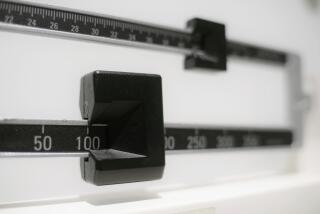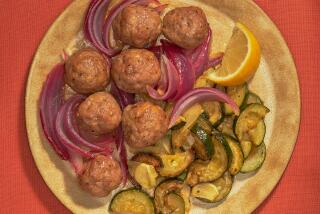Fruits, Vegetables Are the Focus of Five-a-Day Plan
- Share via
To improve the public’s eating habits, health agencies continue to provide nutritional messages that they hope will be understandable and easy to remember. This time the message pertains to eating one’s vegetables.
Last summer, the state’s Department of Health Services announced a new Nutrition and Cancer Prevention Program designed to reduce chronic diseases related to dietary excess and imbalance. Designated the “Five a Day--For Better Health” program, it encouraged Californians to eat at least five servings of fruits and vegetables per day. Although this is one more than the amount recommended in the government’s Four Food Group Plan, a standard measurement of dietary adequacy, it was expected to make eating vegetables a tangible goal.
More recently, the same advice was offered by the National Research Council, a branch of the National Academy of Sciences, which made a similar statement in a report issued last month. In a summary of the report, the NRC encouraged Americans to “eat five or more one-half cup servings a day of a combination of vegetables and fruits, especially green and yellow vegetables and citrus fruits.”
While fresh varieties of fruits and vegetables such as apples, pears, cantaloupes, berries, citrus, carrots, broccoli, cabbage, green beans, squash, peas, spinach, kale and other greens, yams and turnips are typically preferred, frozen can be acceptable alternatives for fresh, which lose nutrients when left unattended for days in the refrigerator before being consumed, according to a spokesperson from the “Five a Day” campaign.
Dried Produce Acceptable
“Dried, frozen and canned vegetables, provided they have no added fat or sugar source and contain fewer than 140 milligrams sodium, are acceptable,” said Brian Krieg, the campaign’s director of marketing, adding that choosing the frozen variety is a “great way” to meet the recommendation. “The frozen is almost identical (to fresh) in nutrients. . . . There’s no nutrient loss--it’s microscopic.”
Rita Storey, registered dietitian and spokesperson for the American Dietetic Assn., agreed. She said that vegetables frozen near the harvesting site have a loss of nutrients that is “very minimal.” In some cases, she said, frozen can be more nutritious, depending upon how long it takes for the fresh vegetables to get to the dinner table.
“Fresh food, obviously, is always preferred,” said Storey, adding that vegetables should be kept frozen from the supermarket to home and frozen immediately.
They are often more nutritious than items that are purchased fresh, then left in the refrigerator a few days. Produce destined for freezing is blanched and frozen within four to six hours after it is picked. This locks in its freshness and flavor, while fresh produce is often harvested early, then allowed to ripen off the vine as it travels to market. This contributes to nutrient and flavor loss, according to the Frozen Food Council.
Things to Keep in Mind
Here are some tips, from the council, to keep in mind when opting for frozen vegetables to meet the desired goal of three to five vegetable servings per day:
--Feel the package. If the vegetables are clumped together, they have been thawed and refrozen, resulting in a loss of quality.
--If the packaging is clear, there should be no crystallization--another sign of thawing and refreezing.
--At the check-out counter, make sure all frozen items are packed together to keep them cold, and head straight home.
--At home, put the frozen items into the freezer immediately. They stay fresh longer at zero degrees--up to six months. Use vegetables stored at 15 degrees within four weeks.
--Pack frozen vegetables loosely in the freezer and store opened packages airtight to prevent freezer burn.
--Use the microwave oven for preparation. Microwaving uses less water than conventional methods, which preserves nutrients that would otherwise be leeched out into the cooking liquid. It also requires no fat to prevent sticking.
MARINATED ANTIPASTO SALAD
1 (10-ounce) package frozen artichoke hearts
1 cup frozen chopped onions
3 cups assorted frozen vegetables
3 cups prepared low-calorie Italian dressing
Green leaf or Romaine lettuce
Fresh basil leaves
Place artichoke hearts, onions and desired vegetables in colander and run under warm water 2 minutes. Drain well. Toss vegetables with dressing in medium bowl. Chill, covered, several hours to marinate, stirring occasionally. Serve on greens. Garnish with basil leaves. Makes 6 servings.
SPINACH LASAGNA
2 pounds part-skim ricotta cheese
4 eggs
1 cup grated Parmesan cheese
1/2 cup chopped Italian parsley
Pepper
1/4 teaspoon ground nutmeg
1/4 cup olive oil
1 (12-ounce) package frozen chopped onions, thawed and squeezed dry
1 (10-ounce) package frozen cut red and green peppers, thawed and squeezed dry
1 (10-ounce) package frozen chopped spinach, thawed and squeezed dry
3 cups prepared spaghetti sauce
1 to 1 1/2 pounds lasagna noodles, cooked
2 cups shredded part-skim mozzarella cheese
Combine ricotta, eggs, Parmesan, parsley, pepper to taste and nutmeg and stir to blend well.
Heat olive oil in large microwave-safe bowl on HIGH (100%) 1 minute. Stir in onions and peppers. Cover with vented plastic wrap and cook on HIGH 2 to 3 minutes until translucent. Add microwaved vegetables and spinach to ricotta. Mix well.
Spoon about 1 cup sauce into bottom of 13x11-inch microwave-safe baking dish. Spread evenly with spatula. Place enough pasta lengthwise in dish to cover bottom. Spread about 4 cups filling evenly over pasta. Sprinkle with 1 cup mozzarella. Add another layer of pasta, 1 cup sauce and remaining filling. Cover with remaining pasta, last cup sauce and remaining mozzarella.
Cover with vented plastic wrap and microwave on MEDIUM-HIGH (75%) 20 minutes or until hot and bubbling. Give dish 1/4 turn every 5 minutes. Remove dish from microwave and let stand 10 minutes before uncovering. Cut into servings. Makes 12 servings.
Note: For smaller ovens, use 8-inch square dish and halve recipe.
CORN RELISH
2 (10-ounce) packages corn in butter sauce
1 1/2 cups chopped green peppers
2/3 cup chopped onion
2/3 cup seeded and chopped unpeeled cucumber
2 tablespoons chopped celery
1 (28-ounce) can whole tomatoes, chopped
2/3 cup sugar
1/2 teaspoon celery seeds
1/2 teaspoon turmeric
1/8 teaspoon dry mustard
1 cup vinegar
2 tablespoons flour
1/4 cup water
Thaw corn pouch 20 minutes in bowl of warm water. Combine corn, green peppers, onion, cucumber, celery, tomatoes, sugar, celery seeds, turmeric, mustard and vinegar in saucepan. Bring to boil, then reduce heat and simmer 20 minutes. Combine flour and water. Stir into mixture. Heat until bubbly and thickened. Pour into hot sterilized jars and seal immediately. Chill to serve. Makes 3 pints.
Note: May be refrigerated several weeks.
RATATOUILLE
1 medium eggplant, cubed
1 (16-ounce) package frozen yellow squash or zucchini
1 (10-ounce) package frozen artichoke hearts
1 cup frozen chopped green peppers
1 cup frozen chopped onions
1 (14-ounce) can stewed tomatoes
1/2 cup chopped parsley
2 teaspoons dried basil leaves
4 cloves garlic, minced
1/4 cup olive oil
Salt, pepper
Combine eggplant, squash, artichoke hearts, peppers, onions, tomatoes, parsley, basil, garlic, olive oil and season to taste with salt and pepper in microwave-safe casserole. Microwave on HIGH (100%) 25 to 30 minutes or until vegetables are tender. Stir once. Makes 4 to 6 servings.
SWISS BROCCOLI TIMBALES
1 (10-ounce) package frozen chopped broccoli
1/2 cup shredded Swiss cheese
1 cup milk
3 eggs
1/2 cup buttermilk baking mix
1/4 teaspoon ground nutmeg
Remove broccoli from package and place in microwave-safe dish. Cover and cook on HIGH (100%) 5 to 7 minutes until cooked. Place in colander and squeeze out excess moisture with back of spoon. Finely chop and set aside 2 tablespoons broccoli. Place remaining broccoli, cheese, milk, eggs, biscuit mix and nutmeg in food processor fitted with steel knife blade.
Mix until combined. Lightly grease 6 custard cups. Spoon mixture evenly into cups. Place in microwave in circle and cook on HIGH 3 minutes. Give each cup 1/2 turn and cook 3 to 4 minutes longer, just until set. Let stand 5 minutes before inverting on serving plate. Garnish with remaining broccoli. Makes 6 servings.
SPINACH PESTO
1 (10-ounce) package frozen chopped spinach
1/2 cup chicken broth
1 tablespoon flour or cornstarch
1/2 teaspoon crushed dried oregano
1/4 cup finely chopped tomatoes
2 tablespoons thinly sliced green onions
2 tablespoons toasted pine nuts
Remove spinach from package and place in microwave-safe dish. Cover and microwave on HIGH (100%) 7 to 8 minutes, until cooked. Drain well.
Place spinach, chicken broth, flour and oregano in food processor. Using steel knife blade, puree. Pour back into cooking bowl and add tomato, green onions and pine nuts. Microwave on HIGH 2 minutes longer. Stir well. Makes 1 1/2 cups.
Note: Spoon pesto over grilled fish, sauteed chicken breasts or toss with cooked pasta.
More to Read
Eat your way across L.A.
Get our weekly Tasting Notes newsletter for reviews, news and more.
You may occasionally receive promotional content from the Los Angeles Times.










